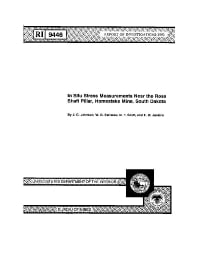Mining Publication: In Situ Stress Measurements Near the Ross Shaft Pillar, Homestake Mine, South Dakota
Original creation date: January 1993
Authors: JC Johnson, WG Pariseau, DF Scott, FM Jenkins
NIOSHTIC2 Number: 10003215
Spokane, WA: U.S. Department of the Interior, Bureau of Mines, RI 9446, 1993 Jan; :1-17
In situ stresses are important input data for the design of safe, stable stope layouts and extraction sequences. However, it is commonly assumed that normal and shear stress gradients in a stress field are negligible and, consequently, that stresses are uniform throughout the region of analysis. To evaluate these assumptions and to provide input data for an analysis of a shaft pillar mining plan, in situ stresses were measured at the Homestake Mine, Lead, South Dakota, using overcoring on hollow inclusion cells and borehole deformation gauges. These measurements were used with conventional least squares, best fit data reduction schemes. The results showed that normal stresses within the shaft pillar were less than, but comparable to, those estimated from finite-element modeling. Shear stresses were an order of magnitude less than normal stresses and varied considerably from site to site. Possible causes of this variability include effects of scale, elastic moduli, anisotropy, and axial strain. Because of the variability, it is not possible to determine the magnitude of horizontal stress gradients.

NIOSHTIC2 Number: 10003215
Spokane, WA: U.S. Department of the Interior, Bureau of Mines, RI 9446, 1993 Jan; :1-17
- Advance and Relieve Mining: A Method to Mitigate the Effects of High Horizontal Stress on the Mine Roof
- Coal Bumps and Odd Dynamic Phenomena - A Numerical Investigation
- Effect of the Dip and Excavation Orientation on Roof Stability in Moderately Dipping Stone Mine Workings
- Effects of Weak Bands on Pillar Stability in Stone Mines: Field Observations and Numerical Model Assessment
- Field Observations and Numerical Studies of Horizontal Stress Effects on Roof Stability in U.S. Limestone Mines
- Investigation of Pillar-Roof Contact Failure in Northern Appalachian Stone Mine Workings
- Pillar Stability Issues Based on a Survey of Pillar Performance in Underground Limestone Mines
- Pillar Strength and Design Methodology for Stone Mines
- Propagation of UHF Radio Waves in Limestone Room and Pillar Mines
- Stability Analysis of a Backfilled Room-and-Pillar Mine